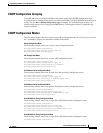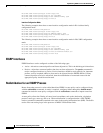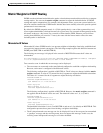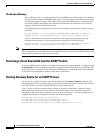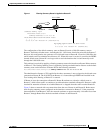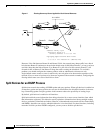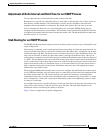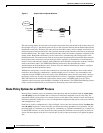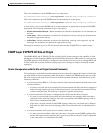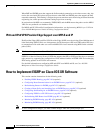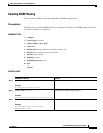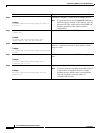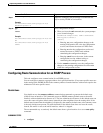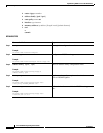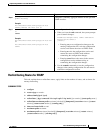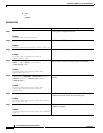
Implementing EIGRP on Cisco IOS XR Software
Information About Implementing EIGRP on Cisco IOS XR Software
RC-147
Cisco IOS XR Routing Configuration Guide
OL-14356-01
This is the command to set the EIGRP metric in a route policy:
RP/0/RP0/CPU0:router(config-rpl)# set eigrp-metric bandwidth delay reliability loading mtu
This is the command to provide EIGRP offset list functionality in a route policy:
RP/0/RP0/CPU0:router(config-rpl)# add eigrp-metric bandwidth delay reliability loading mtu
A route policy can be used in EIGRP only if all the statements are applicable to the particular EIGRP
attach point. The following commands accept a route policy:
• default-information allowed—Match statements are allowed for destination. No set statements are
allowed.
• route-policy—Match statements are allowed for destination, next hop, and tag. Set statements are
allowed for eigrp-metric and tag.
• redistribute—Match statements are allowed for destination, next hop, source-protocol, tag and
route-type. Set statements are allowed for eigrp-metric and tag.
The range for setting a tag is 0 to 255 for internal routes and 0 to 4294967295 for external routes.
EIGRP Layer 3 VPN PE-CE Site-of-Origin
The EIGRP MPLS and IP VPN PE-CE Site-of-Origin (SoO) feature introduces the capability to filter
Multiprotocol Label Switching (MPLS) and IP Virtual Private Network (VPN) traffic on a per-site basis
for EIGRP networks. SoO filtering is configured at the interface level and is used to manage MPLS and
IP VPN traffic and to prevent transient routing loops from occurring in complex and mixed network
topologies.
Router Interoperation with the Site-of-Origin Extended Community
The configuration of the SoO extended community allows routers that support this feature to identify the
site from which each route originated. When this feature is enabled, the EIGRP routing process on the
PE or CE router checks each received route for the SoO extended community and filters based on the
following conditions:
• A received route from BGP or a CE router contains a SoO value that matches the SoO value on the
receiving interface:
–
If a route is received with an associated SoO value that matches the SoO value that is configured
on the receiving interface, the route is filtered out because it was learned from another PE router
or from a backdoor link. This behavior is designed to prevent routing loops.
• A received route from a CE router is configured with a SoO value that does not match:
–
If a route is received with an associated SoO value that does not match the SoO value that is
configured on the receiving interface, the route is accepted into the EIGRP topology table so
that it can be redistributed into BGP.
–
If the route is already installed in the EIGRP topology table but is associated with a different
SoO value, the SoO value from the topology table is used when the route is redistributed into
BGP.
• A received route from a CE router does not contain a SoO value:
–
If a route is received without a SoO value, the route is accepted into the EIGRP topology table,
and the SoO value from the interface that is used to reach the next-hop CE router is appended
to the route before it is redistributed into BGP.



